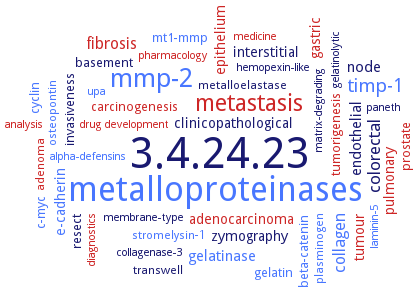3.4.24.23: matrilysin
This is an abbreviated version!
For detailed information about matrilysin, go to the full flat file.

Word Map on EC 3.4.24.23 
-
3.4.24.23
-
metalloproteinases
-
mmp-2
-
metastasis
-
timp-1
-
colorectal
-
fibrosis
-
collagen
-
endothelial
-
node
-
gelatinase
-
e-cadherin
-
clinicopathological
-
zymography
-
interstitial
-
gastric
-
epithelium
-
tumour
-
adenocarcinoma
-
pulmonary
-
basement
-
prostate
-
invasiveness
-
tumorigenesis
-
beta-catenin
-
gelatin
-
carcinogenesis
-
resect
-
mt1-mmp
-
cyclin
-
c-myc
-
adenoma
-
plasminogen
-
transwell
-
osteopontin
-
metalloelastase
-
stromelysin-1
-
laminin-5
-
hemopexin-like
-
pharmacology
-
upa
-
drug development
-
alpha-defensins
-
collagenase-3
-
analysis
-
medicine
-
diagnostics
-
gelatinolytic
-
matrix-degrading
-
paneth
-
membrane-type
- 3.4.24.23
- metalloproteinases
- mmp-2
- metastasis
- timp-1
- colorectal
- fibrosis
- collagen
- endothelial
- node
- gelatinase
- e-cadherin
-
clinicopathological
-
zymography
-
interstitial
- gastric
- epithelium
- tumour
- adenocarcinoma
- pulmonary
-
basement
- prostate
-
invasiveness
- tumorigenesis
- beta-catenin
- gelatin
- carcinogenesis
-
resect
- mt1-mmp
- cyclin
- c-myc
- adenoma
- plasminogen
-
transwell
- osteopontin
- metalloelastase
- stromelysin-1
- laminin-5
-
hemopexin-like
- pharmacology
- upa
- drug development
- alpha-defensins
- collagenase-3
- analysis
- medicine
- diagnostics
-
gelatinolytic
-
matrix-degrading
-
paneth
-
membrane-type
Reaction
Cleavage of Ala14-/-Leu and Tyr16-/-Leu in B chain of insulin. No action on collagen types I, II, IV, V. Cleaves gelatin chain alpha2(I) > alpha1(I) =
Synonyms
cyclic matrix metalloproteinase, human matrix metalloproteinase 7, matrilysin, matrilysin 1, matrilysin-1, Matrin, matrix metallopeptidase 7, matrix metalloprotease-7, Matrix metalloproteinase 7, Matrix metalloproteinase pump 1, Matrix metalloproteinase-7, matrix-metalloproteinase-7, metalloproteinase-7, MMP, MMP 7, MMP-7, MMP7, More, Proteinase, metallo-, pump-1, Proteinase, PUMP-1, PUMP, PUMP-1, Pump-1 protease, Putative (or punctuated) metalloproteinase-1, Putative metalloproteinase, Uterine metalloendopeptidase, Uterine metalloproteinase


 results (
results ( results (
results ( top
top





